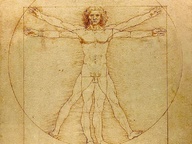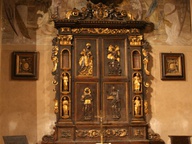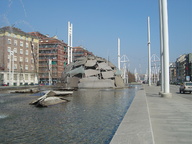Hercules
Perhaps even more than Verrocchio, Pollaiuolo embodies what is thought of as the quintessential Florentine Renaissance artist. He was innovative and unsurpassed in any branch of art he chose to practice. His works seem to radiate a positive, energetic attitude, combining with a new mastery of the athletic male nude often dramatic extremes of passion.
This virile bronze figure of Hercules appears tough, confident, and triumphant -- a hardy progenitor of Michelangelo's colossal David, icon of the next generation of the Renaissance in Florence. The bronze, too, seems a monument to a hero, however small and roughly finished. As a personification of virtue and fortitude, a warrior who fought against tyranny, and as the legendary founder of Florence, Hercules was a local hero. Not only Florence but also the Medici claimed him as their emblem. Pollaiuolo created numerous images of Hercules, among them a painted series of the Labors of Hercules, now lost, for the Medici Palace. Hercules and Antaeus (Bargello, Florence), a bronze depicting a fierce mortal combat that was revolutionary for its day, probably also was made for the Medici.
COMMENTI
LE OPERE
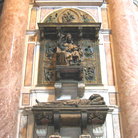 Monumento Funebre per Innocenzo VIII
1497 | Bronzo
Monumento Funebre per Innocenzo VIII
1497 | Bronzo
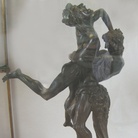 Ercole che uccide Anteo
Bronzo | 45 x 0 cm.
Ercole che uccide Anteo
Bronzo | 45 x 0 cm.
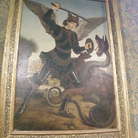 San Michele Arcangelo
Olio su tela
San Michele Arcangelo
Olio su tela
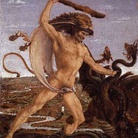 Ercole e l'Idra
1470 | Tempera grassa su tavola | 12 x 17 cm.
Ercole e l'Idra
1470 | Tempera grassa su tavola | 12 x 17 cm.
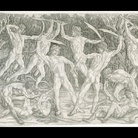 Battaglia di dieci uomini nudi
1460 | Incisione | 60 x 42 cm.
Battaglia di dieci uomini nudi
1460 | Incisione | 60 x 42 cm.
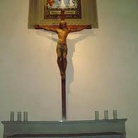 Crocifisso
1470 | Sughero
Crocifisso
1470 | Sughero
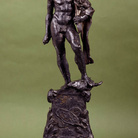 Hercules
1450 | Bronzo | 29 x 44 cm.
Hercules
1450 | Bronzo | 29 x 44 cm.
Map
Works in Italy
Works around the world
